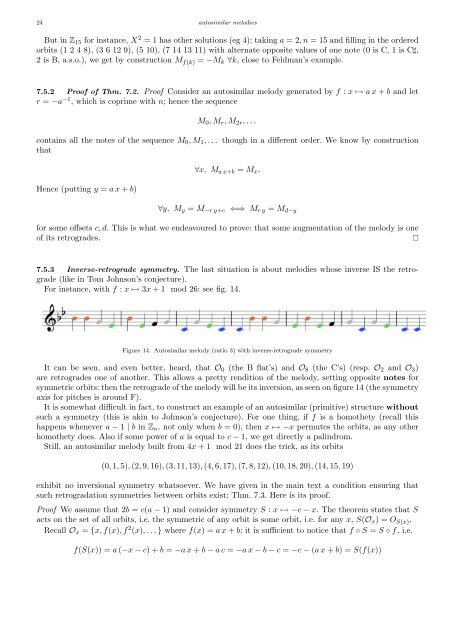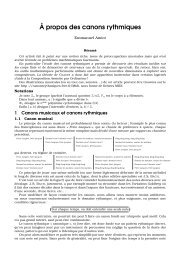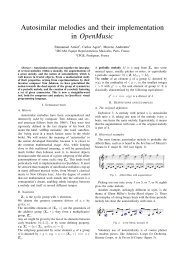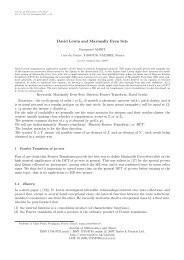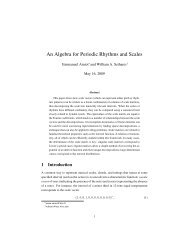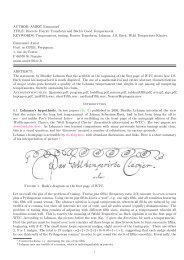Emmanuel Amiot Modèles algébriques et algorithmes pour la ...
Emmanuel Amiot Modèles algébriques et algorithmes pour la ...
Emmanuel Amiot Modèles algébriques et algorithmes pour la ...
You also want an ePaper? Increase the reach of your titles
YUMPU automatically turns print PDFs into web optimized ePapers that Google loves.
24 autosimi<strong>la</strong>r melodies<br />
But in Z15 for instance, X 2 = 1 has other solutions (eg 4); taking a = 2, n = 15 and filling in the ordered<br />
orbits (1 2 4 8), (3 6 12 9), (5 10), (7 14 13 11) with alternate opposite values of one note (0 is C, 1 is C♯,<br />
2 is B, a.s.o.), we g<strong>et</strong> by construction M f(k) = −Mk ∀k, close to Feldman’s example.<br />
7.5.2 Proof of Thm. 7.2. Proof Consider an autosimi<strong>la</strong>r melody generated by f : x ↦→ a x + b and l<strong>et</strong><br />
r = −a −1 , which is coprime with n; hence the sequence<br />
M0, Mr, M2r, . . .<br />
contains all the notes of the sequence M0, M1, . . . though in a different order. We know by construction<br />
that<br />
Hence (putting y = a x + b)<br />
∀x, Ma x+b = Mx.<br />
∀y, My = M−r y+c ⇐⇒ Mr y = Md−y<br />
for some offs<strong>et</strong>s c, d. This is what we endeavoured to prove: that some augmentation of the melody is one<br />
of its r<strong>et</strong>rogrades. <br />
7.5.3 Inverse-r<strong>et</strong>rograde symm<strong>et</strong>ry. The <strong>la</strong>st situation is about melodies whose inverse IS the r<strong>et</strong>rograde<br />
(like in Tom Johnson’s conjecture).<br />
For instance, with f : x ↦→ 3x + 1 mod 26: see fig. 14.<br />
Figure 14. Autosimi<strong>la</strong>r melody (ratio 3) with inverse-r<strong>et</strong>rograde symm<strong>et</strong>ry<br />
It can be seen, and even b<strong>et</strong>ter, heard, that O0 (the B f<strong>la</strong>t’s) and O8 (the C’s) (resp. O2 and O3)<br />
are r<strong>et</strong>rogrades one of another. This allows a pr<strong>et</strong>ty rendition of the melody, s<strong>et</strong>ting opposite notes for<br />
symm<strong>et</strong>ric orbits: then the r<strong>et</strong>rograde of the melody will be its inversion, as seen on figure 14 (the symm<strong>et</strong>ry<br />
axis for pitches is around F).<br />
It is somewhat difficult in fact, to construct an example of an autosimi<strong>la</strong>r (primitive) structure without<br />
such a symm<strong>et</strong>ry (this is akin to Johnson’s conjecture). For one thing, if f is a homoth<strong>et</strong>y (recall this<br />
happens whenever a − 1 | b in Zn, not only when b = 0), then x ↦→ −x permutes the orbits, as any other<br />
homoth<strong>et</strong>y does. Also if some power of a is equal to c − 1, we g<strong>et</strong> directly a palindrom.<br />
Still, an autosimi<strong>la</strong>r melody built from 4x + 1 mod 21 does the trick, as its orbits<br />
(0, 1, 5), (2, 9, 16), (3, 11, 13), (4, 6, 17), (7, 8, 12), (10, 18, 20), (14, 15, 19)<br />
exhibit no inversional symm<strong>et</strong>ry whatsoever. We have given in the main text a condition ensuring that<br />
such r<strong>et</strong>rogradation symm<strong>et</strong>ries b<strong>et</strong>ween orbits exist: Thm. 7.3. Here is its proof.<br />
Proof We assume that 2b = c(a − 1) and consider symm<strong>et</strong>ry S : x ↦→ −c − x. The theorem states that S<br />
acts on the s<strong>et</strong> of all orbits, i.e. the symm<strong>et</strong>ric of any orbit is some orbit, i.e. for any x, S(Ox) = O S(x).<br />
Recall Ox = {x, f(x), f 2 (x), . . . } where f(x) = a x + b; it is sufficient to notice that f ◦ S = S ◦ f, i.e.<br />
f(S(x)) = a (−x − c) + b = −a x + b − a c = −a x − b − c = −c − (a x + b) = S(f(x))


